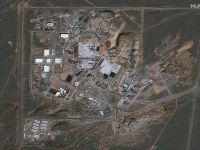Last week marked an unprecedented moment in the Syrian conflict, when opposition groups and Syrian government forces in Zabadani agreed to a 48-hour ceasefire, sit-down negotiations, and a possible population swap in the mixed Sunni-Shiite area in southwestern Syria. But it didn't last long.
On Saturday, Iranian-led talks fell apart, with fresh clashes following the break down. Pro-regime media say a new Zabadani offensive is underway, while a video showed up Sunday purporting to show the Syrian army heading back into the city.
تقدم الجيش السوري والمقاومة اللبنانية تزامن مع اشتباكات تدور في حي الزهرة من الجهة الغربية ل#الزبداني #الميادين http://t.co/lKiJwxvd9T
— قناة الميادين (@AlMayadeenNews) August 16, 2015
Translation: The Syrian army and Hezbollah progress into Zabadani and take control over Naboo area, in the city's northern area.
So how did it all crumble so quickly? Even that is up for debate.
Pro-regime Arabic site al-Mayadeen says government and Iranian forces shut down the ceasefire after rejecting new conditions set forth by the rebels, who they say asked to withdraw their forces to Daraa instead of Idlib, as originally discussed. They say this stipulation broke down talks for a deal that included the swap of some 213 wounded militants in Zabadani for a population of Shiite civilians in the surrounding cities of Fua and Kefraya.
But Ahrar al-Sham, who led negotiations on the opposition side, told a different story.
Al Jazeera reported Sunday that opposition groups were the ones to reject the deal, accusing Tehran of trying to reshuffle the civilian demographics of Zabadani and thus, reshuffle the border boundaries of Syria.
Now it appears the brutal fight for the southwestern area will grind on, and unsurprisingly, the way it got back here is just as murky as the rest of the conflict.







